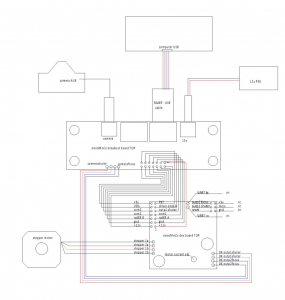Submitted by andre on Fri, 01/10/2014 - 11:59
 We sometimes have customers who ask us how to connect our nanoMoCo break-out-board to the nanoMoCo stepper motor controller. One of our customers was so friendly to draw it all out on this image. Please use this schematic if you need any help with wiring the two boards together.
We sometimes have customers who ask us how to connect our nanoMoCo break-out-board to the nanoMoCo stepper motor controller. One of our customers was so friendly to draw it all out on this image. Please use this schematic if you need any help with wiring the two boards together.
Submitted by andre on Fri, 02/22/2013 - 23:45

We are happy to announce that the Dynamic Perception Graffik Motion Control has reached a public Beta phase. This is the official announcement as made by Dynamic Perception.
Submitted by andre on Fri, 02/15/2013 - 00:35
Today we have great news! Dynamic Perception has made the long awaited Graffik software available on Github. This software can control 32 nanoMoco enabled stepper motors per USB bus. This will allow you to create the most complex multi-axis movements that you need. The software supports both real-time motion control and shoot-move-shoot timelapse photography.
This screen shows the Film Workflow screen, note it's a multi-track style editor which will allow for controlling any kind of MoCoBus-enabled device on the timeline.
Submitted by andre on Sat, 01/05/2013 - 23:38
Dynamic Perception is on the move. They just released new products and they will release a lot more exciting products in 2013. All products will, of course, be available in our ElysiaVisuals store. Here is what is happening at Dynamic Perception
Submitted by andre on Thu, 07/19/2012 - 23:19
We already wrote about the nanoMoCo break out board that we designed. This small board can be connected to the nanoMoCo Stepper Driver board; the future of open source motion control. The standard nanoMoCo board doesn't provide a way to connect the connectors that you need. This is where our ElysiaVisuals break out board comes in.
Submitted by andre on Tue, 07/10/2012 - 21:13
The following user guide can also be found at the site of http://www.dynamicperception.com. The nanoMoCo stepper driver/controller is a specialized, Arduino-compatible* device specifically designed to enable advanced multi-axis stepper-based robotics and automation projects less expensive, and easier to create.
Key features of the nanoMoCo include:
Submitted by andre on Wed, 07/04/2012 - 22:52
Dynamic Perception has announced their long awaited "nanoMoCo Stepper Driver/Controller" boards today. Dynamic Perception's mission is to provide low-cost and easy-to-use photographic motion-control systems. Our focus is to enable creativity and experimentation through open and unencumbered hardware, firmware, and software. Founded by the creators of the OpenMoCo open-source motion-control system we are striving to provide flexible and expandable kits for solving any motion-control need.
Submitted by andre on Fri, 06/15/2012 - 22:51

Dynamic Perception and the Apertus Project have teamed up to produce the first fully integrated camera and motion control system. Together we will expand the capabilities and tools available to filmmakers everywhere, while pushing the envelope in creativity and openness through open-source electronics and hardware.
Submitted by andre on Thu, 06/14/2012 - 16:15
In my last post called "Introduction to time lapse photography" I explained the basics of time lapse photography in combination with a automatically controlled Dynamics Perception dolly. The use of a time lapse slider gives you the possibility to control the motion of your camera in one linear direction. But what about controlling the pan and tilt axis of your camera? Or when you want to rotate your complete subject while you are creating a time lapse sequence?
Submitted by andre on Wed, 06/06/2012 - 13:11
Today I received these PCB's in the post. I designed these myself. That was a difficult road since I had never done this before. Electronics is a hobby of mine, but designing and producing my own boards was always something that I tried to prevent. In the end it wasn't that hard. The board is designed with Eagle, a software package that is free to use for small non commercial boards. The boards were produced in China. The only drawback of that is that you have to wait six weeks before you get your results back.
